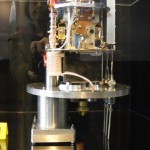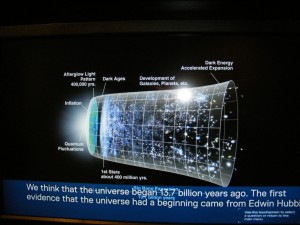Ears, Dishes and Coils
I’ve just been to Jodrell Bank (www.jodrellbank.net ) where I was stunned again by the majestic scale of the Lovell Telescope dish. I went in November 2011 and again in April 2012. Even though I had been before I was awed by the structure appearing in the landscape on the approach to the centre.

Lovell Telescope 2012
The dish is like an enormous version of our own ears, and a bit like the concrete airplane detectors, that were built on the coast to pick up enemy aircraft approaching from over the channel. So the dishes – our scalloped shaped ears – aircraft detector or the Lovell Telescope, all catch and re direct their signals. The transit of sound goes through a series of changes i.e. from sound wave to ear to brain, or radio wave to telescope dish to computer.
[audio:https://shirleypegna.com/wp-content/uploads/2012/05/nesters-in-telescope2.mp3|titles=Birds nesting in telescope]Walking almost underneath the huge dish you can hear the motor of the wheels slowly altering the position of the telescope, and accompanied by the feathered inhabitants that make their nests and bring up their young in the shelter of the slowly perambulating structure.
[audio:https://shirleypegna.com/wp-content/uploads/2012/05/telescope-moving.mp3|titles=telescope moving its position]

http://www.aqpl43.dsl.pipex.com/MUSEUM/COMMS/ear/ear.htm
An acoustic locator dish in Kent, England: built 1928.
This 30-foot high dish is located at Greatstone, Kent. The small concrete hut in front housed the operators. The vertical mast in the centre carried the acoustic pickup tubes.

Ear
At the centre I was struck by the explanation by the display case that showed a radio telescope. It was surprisingly understandable for such a very sophisticated piece of equipment, showing the transit of the radio wave signal through a series of changes. Put simply, the radio waves are focussed in to the middle of the dish; this weak radio wave signal is amplified, although kept from being contaminated by the amplification equipment’s own electronic sound, in various ways, and sent on its way to the computer. Here is the display of the telescope parts and the instructions as seen in the visitors centre.

The ‘feed’ channels the radio waves into the receiver.

Air is pumped out of the ‘vacuum can’ so it cannot conduct heat. Just as a vacuum flask keeps your drink hot, this lets us keep the receiver cold.

The ‘radiation shield’ blocks any thermal radiation from the outer vacuum can, and stops the receiver warming up.

Inside the ‘receiver body’ the radio waves are turned into an electrical signal. This signal is amplified by electronics, which are cooled to about -620 degrees centigrade.

The ‘cold head’ is a refrigerator that continually compresses and then expands helium gas, cooling the receiver. This reduces the noise in the electronics allowing us to detect extremely faint signals arriving from space.
I had been impressed when I found how the magnetic coil of the microphone and speaker worked in a sound system. It’s interesting to me to that both the telescope and the radio’s systems can suggest to us with sound, imagined places that give us an understanding of time and distance regarding real places we may never visit.


http://sciencecity.oupchina.com.hk/npaw/student/glossary/microphone.htm
A while ago I got interested in getting sounds from outside our atmosphere. A friend introduced me to a podcast (Jodcast) Sounds of Space from Jodrell Bank introduced by Tim O’Brien and Stuart Lowe. I wondered what these sounds were, how they came to be this sound in my ears and where they came from. Have a listen to this link! – ‘Sounds of Space’
http://www.jodrellbank.manchester.ac.uk/multimedia/audio/soundsofspace.html
Laid out at the Visitors Centre was simplified and accessible science. I was able to confirm some ideas I had come across before, like that fact that we are hearing different signals picked up in space coming from a range of types of signals on the electromagnetic spectrum. Like the ‘changes’ and ‘transitions ‘ mentioned above these different signals on the spectrum need to go through different transitions to allow our ears to pick up the a limited frequency range of signals the human ear can register.
In the past it has been put to me that these different signals on the electromagnetic spectrum, because they are not audio signals, are in some way false because they need to be transposed to audio signals for us to recognise. I feel that these transpositions are, in part, just more ‘changes and ‘transpositions’ that links the signal to our ears. Even with a Hi-Fi system we make choices about the sound we hear – by choosing different equipment. Transposition or sonifcation of signals from microwaves or x-rays, I find, is an interesting extension of the transpositions we are already familiar with

Picture form the Jodrell Bank Visitors Centre
Time and distance come in to the equation when thinking of sounds from extreme distances, however the scale of the distances and the concepts of time are magnificently grander. The arrays of dishes across the earth: the VLT in Chile high up in the Andes and the SKA (Array) being built in the Southern Hemisphere, and even the moving craft, like the Plank space craft (http://www.jb.man.ac.uk/research/cosmos/planck.html) are getting data-pictures and sound from further and further from us. I find it surprising how recent the discoveries in space technologies are, for instance it’s only since the 1950s that scientists have found the universe is expanding.

Sir Bernard Lovell-picture from the Jodrell Bank Visitors Centre
My own understanding of time is expanding and my reach into the outer atmosphere almost a tangible, audible experience. Thinking into space and time is now not such a completely rarefied an experience, and TV programmes and visitors centres go someway to clarify complex or new science. My ears however are my own equipment here, and I am happy that the chain of events, the transit of sound, takes me via amazing constructions like the Lovell Telescope, to extreme and barely imaginable places.

Lovell Telescope 2012
Some of the telescopes structure housing -a parliament of rooks or was it a murder of crows!